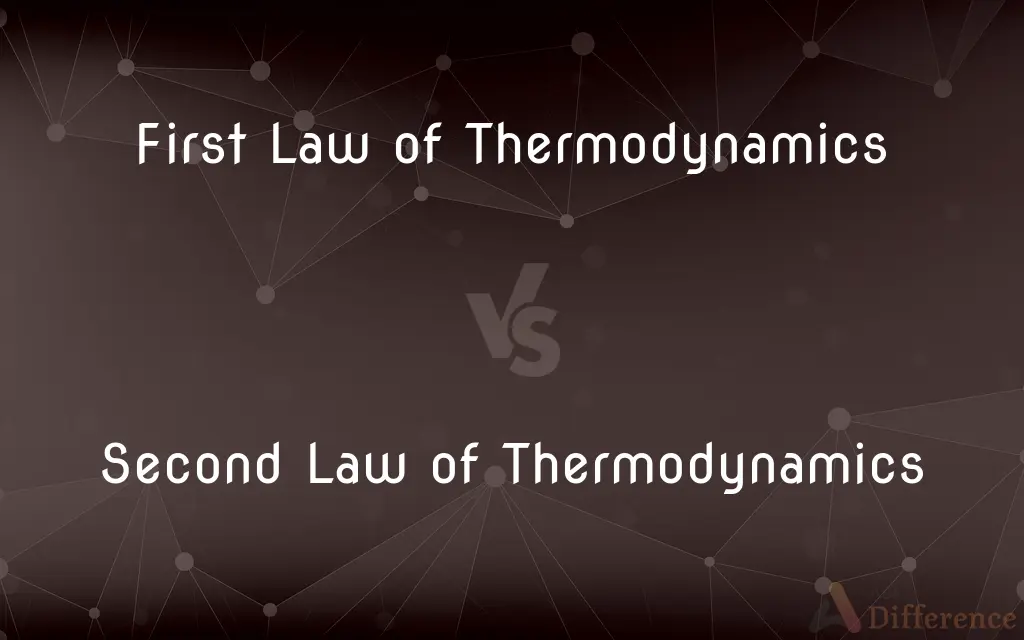First Law of Thermodynamics vs. Second Law of Thermodynamics — What's the Difference?
By Fiza Rafique & Maham Liaqat — Published on March 8, 2024
The First Law of Thermodynamics, focusing on energy conservation, states energy cannot be created or destroyed, only transformed. The Second Law, emphasizing entropy, indicates energy transfers lead to increased disorder.

Difference Between First Law of Thermodynamics and Second Law of Thermodynamics
Table of Contents
ADVERTISEMENT
Key Differences
The First Law of Thermodynamics is a principle of energy conservation, highlighting that the total amount of energy in an isolated system remains constant. It suggests that energy can be transformed from one form to another but cannot be created or destroyed. Whereas, the Second Law of Thermodynamics introduces the concept of entropy, a measure of disorder or randomness in a system. It states that in any energy transfer, there will always be less energy available to do work as some is dispersed in less usable forms, leading to an overall increase in entropy.
The First Law can be applied to various scientific fields, ensuring the conservation of energy principle is respected in mechanics, quantum physics, and chemistry. It provides a quantitative tool to analyze energy transformations and work interactions. On the other hand, the Second Law is essential for understanding the irreversibility of natural processes and the efficiency limits of energy conversion systems. It explains why not all energy can be converted into work and the inevitable progression towards disorder.
In practical applications, the First Law is used to design energy-efficient systems, calculate energy requirements, and evaluate the total energy changes in processes. Engineers and scientists use it to ensure energy balance in systems such as engines and reactors. Whereas the Second Law influences the design and optimization of thermal systems like refrigerators and heat pumps, focusing on maximizing efficiency and minimizing energy waste through understanding entropy changes.
The First Law emphasizes the quantitative conservation of energy, providing a foundation for energy analysis in closed systems. It allows for the prediction and calculation of energy changes, facilitating the engineering of systems based on energy transformations. On the other hand, the Second Law introduces a qualitative aspect to thermodynamics, focusing on the directionality of processes and the concept of usable energy, which influences the design and operation of all types of energy conversion and transfer systems.
Both laws are fundamental to thermodynamics but serve different purposes. The First Law offers a lens to view the universe as energy-conserving, enabling precise energy management in technological applications. Conversely, the Second Law provides insights into the natural tendency towards disorder, guiding the development of more efficient energy conversion strategies and understanding the universe's temporal evolution.
ADVERTISEMENT
Comparison Chart
Fundamental Principle
Energy conservation: Energy cannot be created or destroyed.
Entropy increase: Energy transfers result in increased disorder.
Focus
Energy transformation and conservation.
Efficiency of energy transfer and increase in disorder.
Applications
Energy balance calculations, system design based on energy transformations.
Designing efficient thermal systems, understanding natural process limitations.
Impact on Energy Conversion
Ensures the total energy remains constant during conversion.
Limits the efficiency of energy conversion due to entropy increase.
Contribution to Thermodynamics
Provides a quantitative measure of energy changes in processes.
Introduces a qualitative understanding of process directionality and efficiency.
Compare with Definitions
First Law of Thermodynamics
Energy in an isolated system is constant.
In a closed bottle, the energy from a chemical reaction is converted to heat, not lost.
Second Law of Thermodynamics
Highlights the inevitable progression towards disorder.
Over time, buildings deteriorate due to the natural increase in entropy.
First Law of Thermodynamics
Provides a framework for analyzing energy exchanges.
Understanding a car engine's operation requires applying the First Law.
Second Law of Thermodynamics
Entropy of an isolated system tends to increase.
Mixing hot and cold water results in a uniform temperature, increasing disorder.
First Law of Thermodynamics
Basis for energy conservation in processes.
Calculating the efficiency of a steam engine involves the First Law.
Second Law of Thermodynamics
Explains the directionality of natural processes.
Heat naturally flows from hot to cold objects, never the reverse.
First Law of Thermodynamics
Governs the energy balance in closed systems.
In an ecosystem, the total energy from sunlight is distributed among living things.
Second Law of Thermodynamics
Efficiency of energy conversions is limited.
A car engine cannot convert all its fuel energy into motion.
First Law of Thermodynamics
Transformation of energy forms without loss.
Electrical energy transforms into kinetic energy in a motor without disappearing.
Second Law of Thermodynamics
Critical for designing thermal systems.
Refrigerators are designed considering the Second Law to remove heat efficiently.
Common Curiosities
Why is the Second Law important for understanding energy efficiency?
It explains why energy conversions are never 100% efficient due to the inevitable increase in entropy.
How do these laws apply to engineering?
They guide the design and optimization of energy systems, ensuring energy conservation (First Law) and maximizing efficiency (Second Law).
What is the First Law of Thermodynamics?
It states that energy in an isolated system remains constant and can neither be created nor destroyed, only transformed.
How does the Second Law of Thermodynamics differ from the First?
The Second Law focuses on entropy, stating that in any energy transfer, there is an increase in disorder, unlike the First Law, which focuses on the conservation of energy.
What real-world phenomenon does the Second Law explain?
It explains the inefficiency of engines and refrigerators and the natural tendency towards disorder.
Can the First Law predict the direction of a process?
No, the First Law does not indicate the direction of a process; it only ensures energy conservation.
What does the Second Law say about entropy?
It states that the entropy of an isolated system not in equilibrium almost always increases over time.
Can energy be destroyed according to the First Law?
No, according to the First Law, energy cannot be destroyed, only converted to different forms.
Can the First Law be applied to open systems?
Yes, it can be applied by considering the energy exchanged with the environment.
How does the First Law affect environmental science?
It underpins the principle of energy flow in ecosystems and the conservation of energy in environmental processes.
Does the Second Law imply all processes are irreversible?
Yes, in a practical sense, because it leads to an increase in entropy, making the reverse process energetically unfavorable.
How do these laws interrelate in thermodynamic cycles?
They provide a framework for analyzing the energy transformations and efficiency of cycles, such as in engines or refrigerators.
What is an example of the First Law in action?
In hydroelectric power plants, potential energy of water is converted into electrical energy, adhering to the First Law.
Is it possible to design a perfectly efficient machine?
No, the Second Law implies that no machine can be perfectly efficient due to entropy increase.
Share Your Discovery

Previous Comparison
Kurta vs. Kurtis
Next Comparison
POP vs. IMAPAuthor Spotlight
Written by
Fiza RafiqueFiza Rafique is a skilled content writer at AskDifference.com, where she meticulously refines and enhances written pieces. Drawing from her vast editorial expertise, Fiza ensures clarity, accuracy, and precision in every article. Passionate about language, she continually seeks to elevate the quality of content for readers worldwide.
Co-written by
Maham Liaqat















































